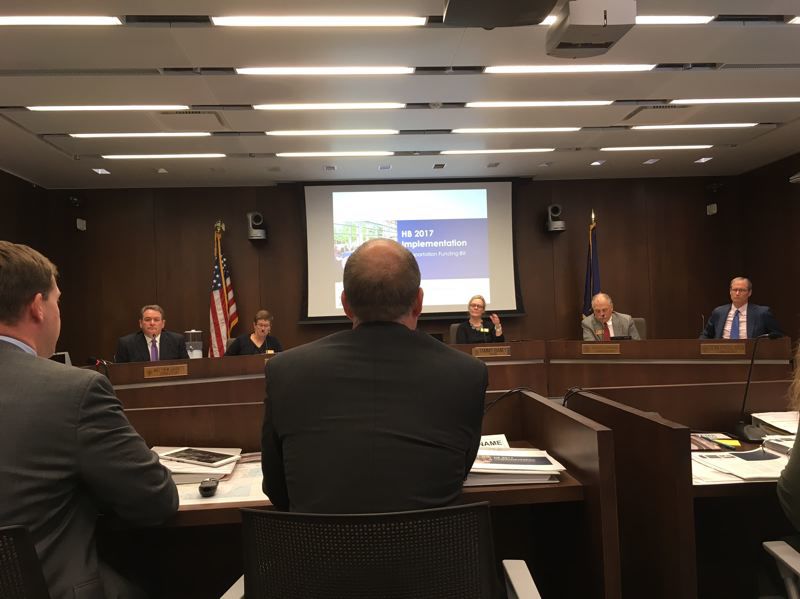Interstate tolls looming for metro area
Published 7:00 am Monday, July 24, 2017

- PAMPLIN MEDIA GROUP: PETER WONG - Oregon Transportation Commission members hear details of the recently approved transportation funding bill (HB 2017) approved by the 2017 Legislature at a meeting Thursday, July 20. Seated from left is Travis Brouwer, assistant director for public affairs, and Paul Mather, Highway Division chief, Oregon Department of Transportation.
Motorists will face the possibility of tolls on Interstates 5 and 205 in the metropolitan area, but not until 2019 after a study is completed — and only if the Federal Highway Administration says yes.
Tolls are envisioned as part of the multibillion-dollar plan for transportation projects approved by the 2017 Oregon Legislature.
The legislation (House Bill 2017) also requires the Oregon Department of Transportation to report by February — six months away — how much it will cost to widen I-205 between Stafford Road and the George Abernethy Bridge and to reinforce the bridge against severe earthquakes.
But the bill provides no specific funding for that work, unlike two other major highway projects proposed in the region. Some money for I-205 was included in an initial version proposing $8.2 billion in spending over 10 years, but it was dropped in the final plan for $5.3 billion.
“There is something in this package for everyone,” said Clackamas County Commissioner Paul Savas, who is on the Joint Advisory Committee on Transportation for Metro.
“There is also something in this package for everyone to dislike. I hope people will support it. We all are not going to win but we all are going to have to pay for it.”
Toll plan in 2018
The legislation directs the Oregon Transportation Commission, ODOT’s policy-making board, to submit a tolling proposal to the Federal Highway Administration by the end of 2018.
I-5 and I-205 are affected from their junction in Tualatin north to the Columbia River. That’s about 20 miles of I-5 and 25 miles of I-205.
If the federal agency says yes, the state commission must inform lawmakers and implement the proposal. No public vote is required.
ODOT’s Portland regional office will set up a committee with local officials and others to advise the agency about what is described as “value pricing.”
Possibilities include tolls during hours of peak traffic congestion, or an express toll lane — similar to what is in operation on I-405 on Seattle’s eastern suburbs — that is alongside regular traffic lanes. California also has some toll roads.
“What they entail is charging a price for the use of a transportation facility that varies based on the time of day or the level of congestion on the facility,” said Travis Brouwer, ODOT assistant director for public affairs.
“We need to develop some form of variable-rate pricing of roads that would help address some of our congestion concerns.”
Brouwer and other ODOT officials spoke at a commission meeting Thursday (July 20).
Oregon law dating back more than two decades already allows for tolls. The state commission worked on detailed policies between 2009 and 2012, and it discussed tolls with an expert from Cambridge Systematics on May 18.
“I remember how much time we spent on tolling a few years ago and how complex it is,” said state commission member Dave Lohman of Ashland. “I am nervous about delivering in that (18-month) time frame.”
Tolls have not been imposed in Oregon. The proposed Columbia River Crossing between Portland and Vancouver, Wash., envisioned them, but Oregon dropped work on the bridge project after the Washington Legislature failed to act in 2013.
The key decision lies with the Federal Highway Administration, because tolls are generally barred from existing interstate highways. (Some of them already were toll roads, particularly in the East Coast and Midwest, before the interstate system was established in the mid-1950s.)
The agency can grant exceptions to the no-toll rule if those highways cannot be maintained or improved without tolls. Exceptions also are allowed for conversions to high-occupancy traffic lanes.
Savas said that from Clackamas County’s perspective, the process needs to be accelerated.
“We cannot be in limbo for another year and a half about whether tolling is going to work or not,” he said.
Mixed reactions
Although their word is only advisory, Clackamas County commissioners expressed mixed feelings Tuesday (July 18) on the possibility of tolls.
Commissioner Ken Humberston said tolling is a last resort — and so are the expansions proposed for I-205.
“The reality is that … you are not going to expand your way by freeway out of this traffic (congestion) as long as the area is growing,” he said.
“That’s been tried in every other metropolitan area in this country and it does not work. If you build more freeways there will be more cars. In the final analysis it is going to take alternative forms of transportation to reduce congestion.”
Board Chairman Jim Bernard expressed strong disappointment at the omission of I-205 funding. He said it makes no sense to impose tolls on I-205 but not on I-5.
“If they are not going to fix I-205, that is not a value proposition to me,” he said.
Several Clackamas County lawmakers voted against HB 2017, some because it omits funding for I-205 work and some because it allows tolls on I-205 and I-5. But their votes were essentially protests; HB 2017 passed the House, 39-20, and the Senate, 22-7.
Among them were Reps. Karin Power of Milwaukie and Janelle Bynum of Happy Valley, both Democrats who mentioned the cost to residents and the uncertainty about I-205 work.
“Anything that raises the cost of getting around is troubling to me,” Power was quoted as saying in Willamette Week.
Rep. Mark Meek of Gladstone also was among the six Democrats opposed, as well as 14 Republicans.
ODOT’s Brouwer said there are other considerations for tolls, such as billing, collecting and customer service, which ODOT is likely to contract out.
“It may not pencil out in certain areas. There are a lot of components that go into whether something is viable,” said Tammy Baney of Bend, the state commission chairwoman and a Deschutes County commissioner.
“But I think we are at a crossroads in Oregon. We need to look at all options to make sure we are exhausting those and taking into consideration all factors.”
pwong@pamplinmedia.com
twitter.com/capitolwong
No funding guarantee
The legislation itself contains no funding, but the new Oregon transportation package (HB 2017) requires legislators to get an estimate of how much it will cost for major work on Interstate 205.
The work calls for widening six miles of I-205 between Stafford Road and the George Abernethy Bridge from two to three lanes each way, and to strengthen that bridge against earthquakes.
The deadline for the Oregon Department of Transportation to submit an estimate is Feb. 1.
The bridge, which spans the Willamette River and connects West Linn and Oregon City, was built in 1970, before I-205 was completed in 1982. ODOT has twice applied for federal grants for the project, which was estimated at a $122 million total back in December, but both bids failed to win a share of an annual national pot of $850 million.
Other work on I-205 is envisioned in HB 2017: Congestion relief in Multnomah County between Powell Boulevard and the interchange with I-84, and traffic management signals similar to those already in use on Highway 217. But that work is separate from the more costly highway widening and bridge strengthening.
I-205 is designated as a corridor of national significance under 2015 congressional legislation that renewed federal transportation spending authority for five years.
Unlike two other high-priority regional highway projects — auxiliary lanes on Highway 217 in Washington County, and a reworking of the Rose Quarter interchange of I-5 and I-84 in Portland — the 2017 legislation does not guarantee money for I-205.
The Highway 217 work is estimated at $100 million. ODOT must submit an estimate for the Rose Quarter project by February 2020, two years after the I-205 project, but a portion of increased fuel taxes under the 2017 legislation is earmarked for bonds to help pay for what is likely to be a costly project.





